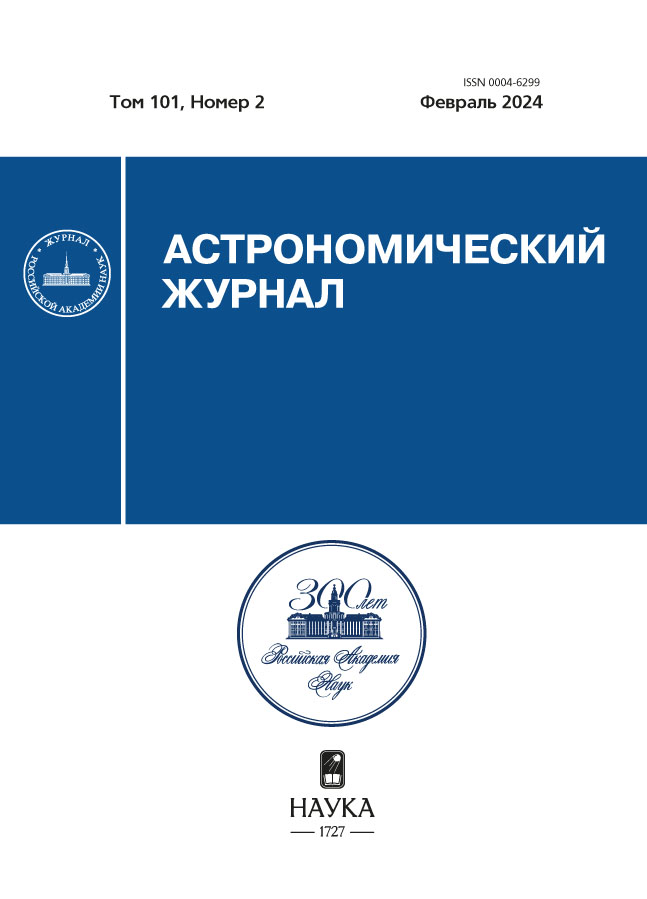Unresolved binary systems with white dwarfs in open star clusters
- Авторлар: Mikhnevich V.O.1, Seleznev A.F.1
-
Мекемелер:
- Ural Federal University
- Шығарылым: Том 101, № 2 (2024)
- Беттер: 92-100
- Бөлім: Articles
- URL: https://jdigitaldiagnostics.com/0004-6299/article/view/647586
- DOI: https://doi.org/10.31857/S0004629924020037
- EDN: https://elibrary.ru/KTKMBF
- ID: 647586
Дәйексөз келтіру
Аннотация
We invesigate unresolved binary systems with components of main sequence star (MS) and white dwarf (WD) in nine open clusters. These systems are located below and to the left of the main sequence at the colour-magnitude diagram. We compare the number of cluster stars, which have likely evolved into white dwarfs, with the number of candidates for unresolved binary systems with WD. The number of probable cluster members, lying below the main sequence, is generally less than the expected number of white dwarfs. The observations in the ultraviolet could detect WDs and unresolved binary WD+MS systems more confidently than the observations in the visible range.
Негізгі сөздер
Толық мәтін
Авторлар туралы
V. Mikhnevich
Ural Federal University
Хат алмасуға жауапты Автор.
Email: varvara.mikhnevich@urfu.ru
Ресей, Еkaterinburg
A. Seleznev
Ural Federal University
Email: varvara.mikhnevich@urfu.ru
Ресей, Еkaterinburg
Әдебиет тізімі
- M. Limongi, L. Roberti, A. Chieffi, and K. Nomoto, Astrophys. J. Suppl. 270, 29 (2024).
- I. Iben and M. Livio, Publ. Astron. Soc. Pacific 105, 1373 (1993).
- K. A. Postnov and L. R. Yungelson, Liv. Rev. Relativity 17, 3 (2014).
- M. Livio and N. Soker, Astrophys. J. 329, 764 (1988).
- T. M. Tauris, D. Sanyal, S.-C. Yoon, and N. Langer, Astron. and Astrophys. 558, id. A39 (2013).
- F. K. Röpke and O. de Marco, Liv. Rev. Computational Astrophys. 9(1), id. 2 (2023).
- J. D. Cummings, J. S. Kalirai, P.-E. Tremblay, E. Ramirez-Ruiz, and J. Choi, Astrophys. J. 866(1), id. 21 (2018).
- L. Ferrario, D. Wickramasinghe, J. Liebert, K. A. Williams, Monthly Not. Roy. Astron. Soc. 361(4), 1131 (2005).
- V.V. Nikiforova, M.V. Kulesh, A.F. Seleznev, and G. Carraro, Astron. J. 160(3), id. 142 (2020).
- J. Liebert, Ann. Rev. Astron. Astrophys. 18, 363 (1980).
- D. Koester and G. Chanmugam, Reports Progress Phys. 53, 837 (1990).
- L. G. Althaus, A. H. Córsico, J. Isern, and E. Garcia-Berro, Astron. and Astrophys. Rev. 18(4), 471 (2010).
- T. Prusti, J. H. J.de Bruijne, A. G. A. Brown, A. Vallenari, et al., Astron. and Astrophys. 595, id. A1 (2016).
- [ R. Ahumada, C. Allende Prieto, A. Almeida, F. Anders, et al., Astrophys. J. Suppl. 249(1), id. 3 (2020).
- N. P. Gentile Fusillo, P.-E. Tremblay, E. Cukanovaite, A. Vorontseva, et al., Monthly Not. Roy. Astron. Soc. 508(3), 3877 (2021).
- H. B. Richer, I. Caiazzo, H. Du, S. Grondin, et al., Astrophys. J. 912(2), id. 165 (2021).
- M. Prišegen, M. Piecka, N. Faltová, N., M. Kajan, and E. Paunzen, Astron. and Astrophys. 645, id. A13 (2021).
- M. Prišegen and N. Faltová, Astron. and Astrophys. 678, id. A20 (2023).
- H.A. Flewelling, E.A. Magnier, K.C. Chambers, J.N. Heasley, et al., Astrophys. J. Suppl. 251(1), id. 7 (2020).
- L. Bianchi, B. Shiao, and D. Thilker, Astrophys. J. Suppl. 230(2), id. 24 (2017).
- G. Duchéne and A. Kraus, Ann. Rev. Astron. Astrophys. 51(1), 269 (2013).
- A. E. Piskunov and O. Yu. Malkov, Astron. and Astrophys. 247, 87 (1991).
- R. de Grijs, S. P. Goodwin, M. B. N. Kouwenhoven, and P. Kroupa, Astron. and Astrophys. 492(3), 685 (2008).
- P. Kroupa, C. A. Tout, and G. Gilmore, Monthly Not. Roy. Astron. Soc. 251, 293 (1991).
- O.I. Borodina, A.F. Seleznev, G. Carraro, and V.M. Danilov, Astrophys. J. 874, id. 127 (2019).
- O.I. Borodina, G. Carraro, A.F. Seleznev, and V.M. Danilov, Astrophys. J. 908(1), id. 60 (2021).
- A. A. Malofeeva, A. F. Seleznev, and G. Carraro, Astron. J. 163(3), id. 113 (2022).
- A. A. Malofeeva, V. O. Mikhnevich, G. Carraro, G., and A. F. Seleznev, Astron. J. 165(2), id. 45 (2023).
- A. Bressan, P. Marigo, L. Girardi, B. Salasnich, C. Dal Cero, S. Rubele, and A. Nanni, Monthly Not. Roy. Astron. Soc. 427, 127 (2012).
- T. Cantat-Gaudin, F. Anders, A. Castro-Ginard, C. Jordi, et al., Astron. and Astrophys. 640, id. A1 (2020).
- W. S. Dias, H. Monteiro, A. Moitinho, J. R. D. Lepine, G. Carraro, E. Paunzen, B. Alessi, and L. Villela, Monthly Not. Roy. Astron. Soc. 504, 356 (2021).
- E. L. Hunt and S. Reffert, Astron. and Astrophys. 673, id. A114 (2023).
- P. Marigo, J. D. Cummings, J. L. Curtis, J. Kalirai, et al., Nature Astron. 4, 1102 (2020).
- P.D. Dobbie, R. Napiwotzki, M.R. Burleigh, K.A. Williams, R. Sharp, M. A. Barstow, S. L. Casewell, and I. Hubeny, Monthly Not. Roy. Astron. Soc. 395, 2248 (2009).
- J. Parada, H. Richer, J. Heyl, J. Kalirai, and R. Goldsbury, Astrophys. J. 826(1), id. 88 (2016).
- J. Parada, H. Richer, J. Heyl, J. Kalirai, and R. Goldsbury, Astrophys. J. 830(2), id. 139 (2016).
- P. A. Bergbusch and P. B. Stetson, Astron. J. 138, 1455 (2009).
- S. Chen, H. Richer, I. Caiazzo, and J. Heyl, Astrophys. J. 867(2), id. 132 (2018).
- Б. М. Шустов, М. Е. Сачков, А. А. Боярчук, Вестник ФГУП НПО им. С. А. Лавочкина 5, 4 (2014).
- А. Ф. Селезнев и В. О. Михневич, Научные труды Института астрономии РАН 8(5), 241 (2023).
Қосымша файлдар














